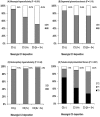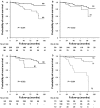Decreased circulating C3 levels and mesangial C3 deposition predict renal outcome in patients with IgA nephropathy
- PMID: 22792353
- PMCID: PMC3391269
- DOI: 10.1371/journal.pone.0040495
Decreased circulating C3 levels and mesangial C3 deposition predict renal outcome in patients with IgA nephropathy
Abstract
Background and aims: Mesangial C3 deposition is frequently observed in patients with IgA nephropathy (IgAN). However, the role of complement in the pathogenesis or progression of IgAN is uncertain. In this observational cohort study, we aimed to identify the clinical implications of circulating C3 levels and mesangial C3 deposition and to investigate their utility as predictors of renal outcomes in patients with IgAN.
Methods: A total of 343 patients with biopsy-proven IgAN were enrolled between January 2000 and December 2008. Decreased serum C3 level (hypoC3) was defined as C3 <90 mg/dl. The study endpoint was end-stage renal disease (ESRD) and a doubling of the baseline serum creatinine (D-SCr).
Results: Of the patients, there were 66 patients (19.2%) with hypoC3. During a mean follow-up of 53.7 months, ESRD occurred in 5 patients (7.6%) with hypoC3 compared with 9 patients (3.2%) with normal C3 levels (P = 0.11). However, 12 patients (18.2%) with hypoC3 reached D-SCr compared with 17 patients (6.1%) with normal C3 levels [Hazard ratio (HR), 3.59; 95% confidence interval (CI), 1.33-10.36; P = 0.018]. In a multivariable model in which serum C3 levels were treated as a continuous variable, hypoC3 significantly predicted renal outcome of D-SCr (per 1 mg/dl increase of C3; HR, 0.95; 95% CI, 0.92-0.99; P = 0.011). The risk of reaching renal outcome was significantly higher in patients with mesangial C3 deposition 2+ to 3+ than in patients without deposition (HR 9.37; 95% CI, 1.10-80.26; P = 0.04).
Conclusions: This study showed that hypoC3 and mesangial C3 deposition were independent risk factors for progression, suggesting that complement activation may play a pathogenic role in patients with IgAN.
Conflict of interest statement
Figures









Similar articles
-
Mesangial C3 deposition and serum C3 levels predict renal outcome in IgA nephropathy.Clin Exp Nephrol. 2021 Jun;25(6):641-651. doi: 10.1007/s10157-021-02034-7. Epub 2021 Feb 23. Clin Exp Nephrol. 2021. PMID: 33620604
-
Glomerular C4 deposition and glomerulosclerosis predict worse renal outcomes in Chinese patients with IgA nephropathy.Ren Fail. 2020 Nov;42(1):629-637. doi: 10.1080/0886022X.2020.1786400. Ren Fail. 2020. PMID: 32660366 Free PMC article.
-
Histological reappraisal of IgA nephropathy: the role of glomerular pattern of injury and mesangial complement deposition.BMC Nephrol. 2024 Apr 24;25(1):145. doi: 10.1186/s12882-024-03577-z. BMC Nephrol. 2024. PMID: 38658875 Free PMC article.
-
IgA nephropathy: common nephritis leading to end-stage renal failure.Int J Artif Organs. 1994 Sep;17(9):457-60. Int J Artif Organs. 1994. PMID: 7890432 Review.
-
Proliferative glomerulonephritis with monoclonal immunoglobulin G deposits complicated by immunoglobulin A nephropathy in the renal allograft.Nephrology (Carlton). 2016 Jul;21 Suppl 1:48-52. doi: 10.1111/nep.12775. Nephrology (Carlton). 2016. PMID: 26971743 Review.
Cited by
-
Evaluating Progression Risk in Patients With Immunoglobulin A Nephropathy.Kidney Int Rep. 2023 Sep 22;8(12):2515-2528. doi: 10.1016/j.ekir.2023.09.020. eCollection 2023 Dec. Kidney Int Rep. 2023. PMID: 38106572 Free PMC article. Review.
-
A narrative review of potential drug treatments for nephritis in children with IgA vasculitis (HSP).Clin Rheumatol. 2023 Dec;42(12):3189-3200. doi: 10.1007/s10067-023-06781-8. Epub 2023 Sep 27. Clin Rheumatol. 2023. PMID: 37755547 Free PMC article. Review.
-
Hypocomplementemic Atypical IgA Vasculitis: A Case Report.Front Pediatr. 2022 Jun 9;10:886371. doi: 10.3389/fped.2022.886371. eCollection 2022. Front Pediatr. 2022. PMID: 35757129 Free PMC article.
-
The clinical and pathological characteristics of IgA nephropathy patients in Tibet.BMC Nephrol. 2022 Jul 27;23(1):269. doi: 10.1186/s12882-022-02895-4. BMC Nephrol. 2022. PMID: 35896958 Free PMC article.
-
The relationship between serum uric acid levels and glomerular ischemic lesions in patients with Immunoglobin A nephropathy-a analytical cross-sectional study.BMC Nephrol. 2022 Jul 18;23(1):255. doi: 10.1186/s12882-022-02880-x. BMC Nephrol. 2022. PMID: 35850659 Free PMC article.
References
-
- D'Amico G. The commonest glomerulonephritis in the world: IgA nephropathy. Q J Med. 1987;64:709–727. - PubMed
-
- D'Amico G, Colasanti G, Barbiano di Belgioioso G, Fellin G, Ragni A, et al. Long-term follow-up of IgA mesangial nephropathy: clinico-histological study in 374 patients. Semin Nephrol. 1987;7:355–358. - PubMed
-
- Li PK, Ho KK, Szeto CC, Yu L, Lai FM. Prognostic indicators of IgA nephropathy in the Chinese–clinical and pathological perspectives. Nephrol Dial Transplant. 2002;17:64–69. - PubMed
-
- D'Amico G. Natural history of idiopathic IgA nephropathy and factors predictive of disease outcome. Semin Nephrol. 2004;24:179–196. - PubMed
Publication types
MeSH terms
Substances
LinkOut - more resources
Full Text Sources
Medical
Miscellaneous

